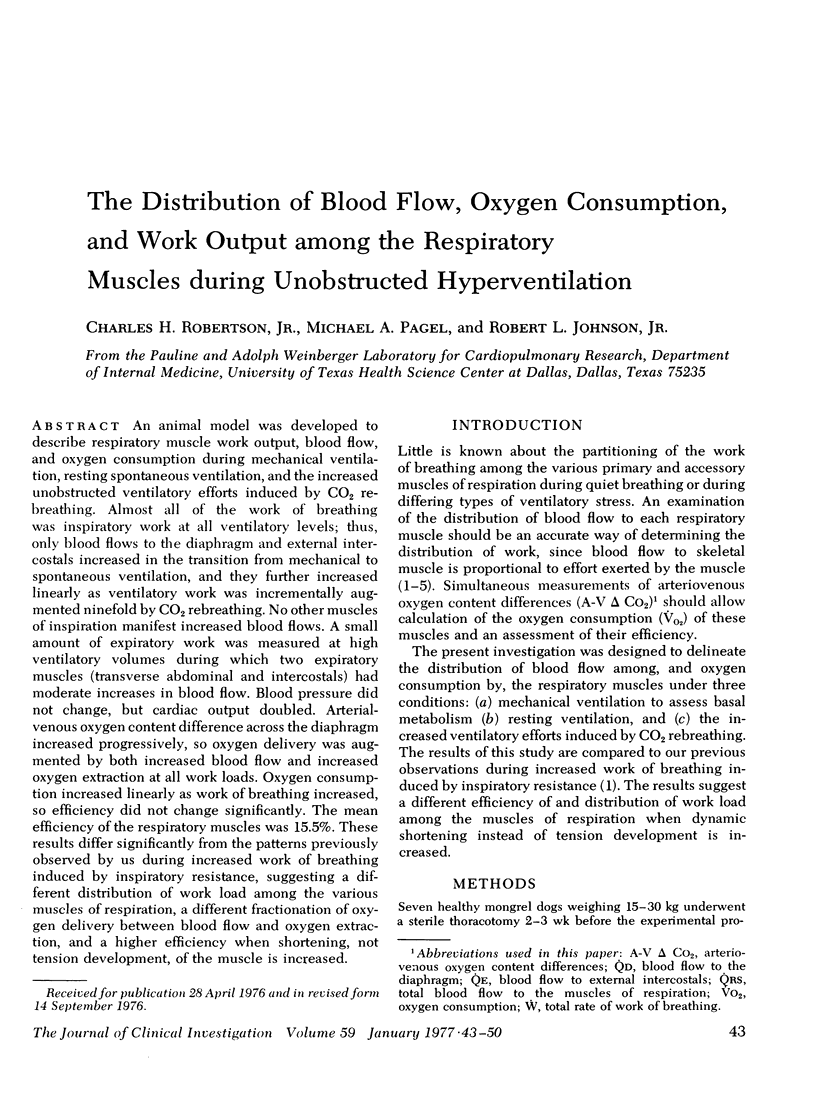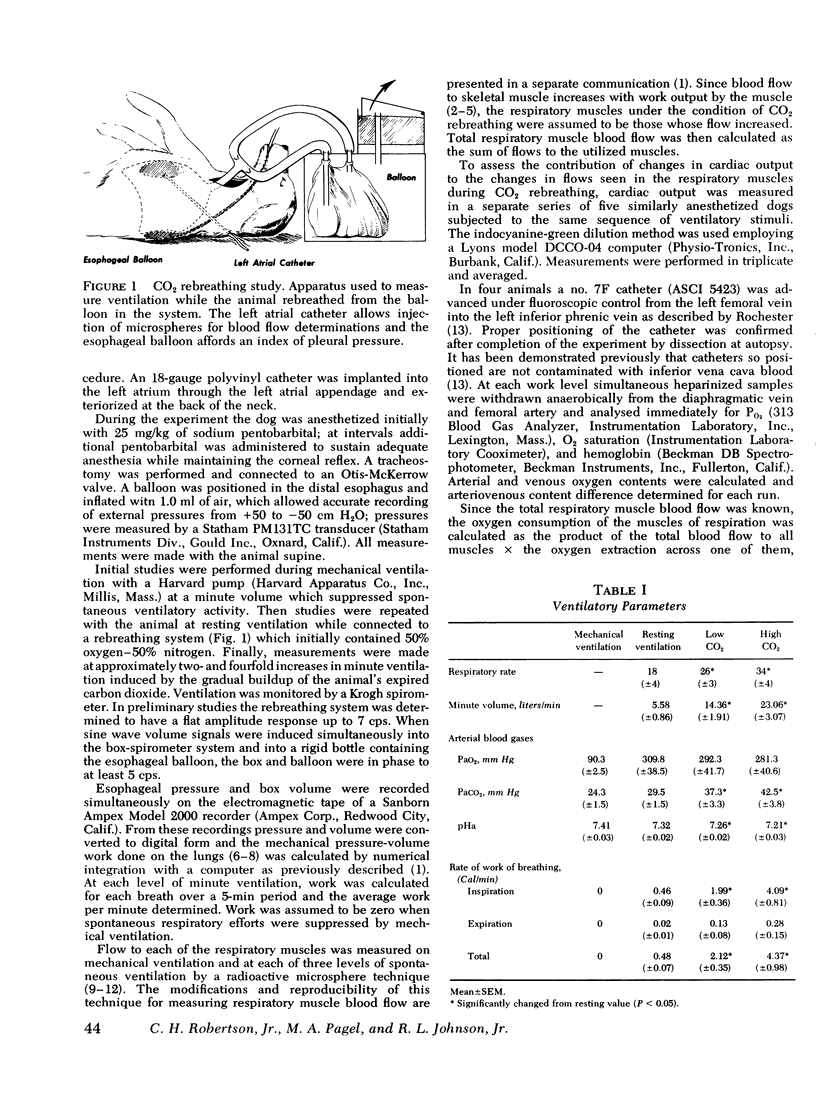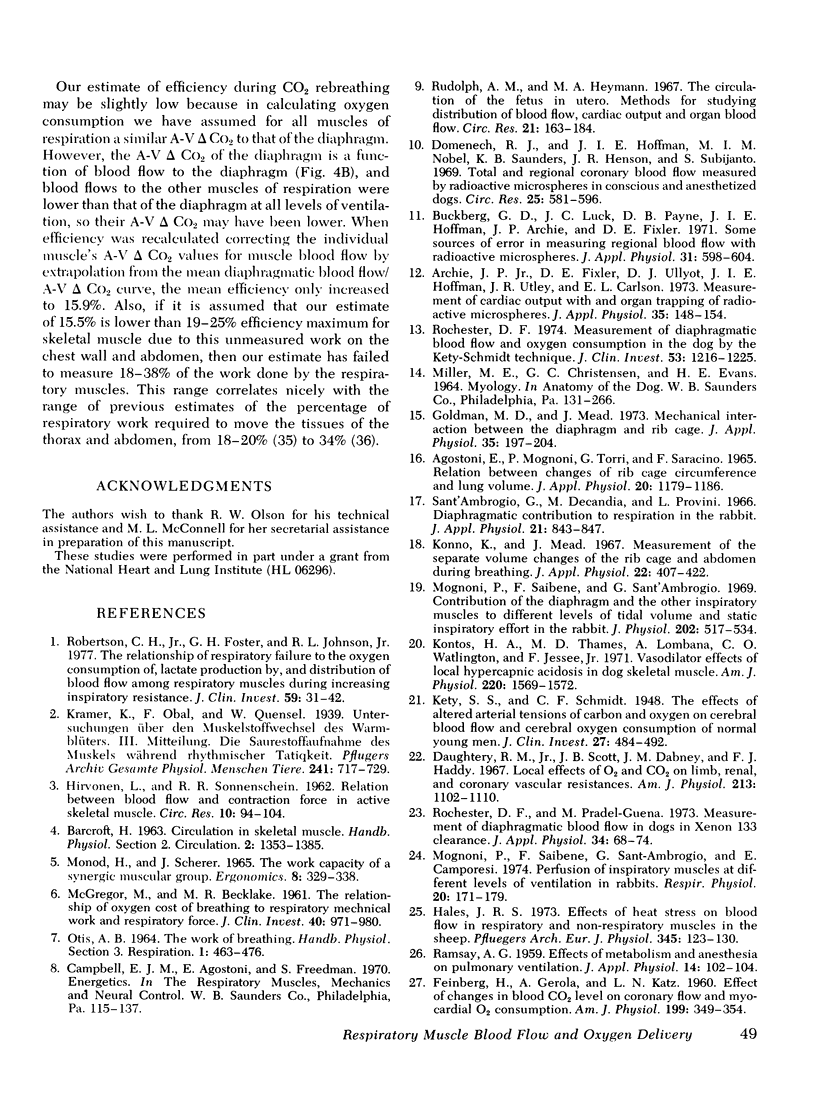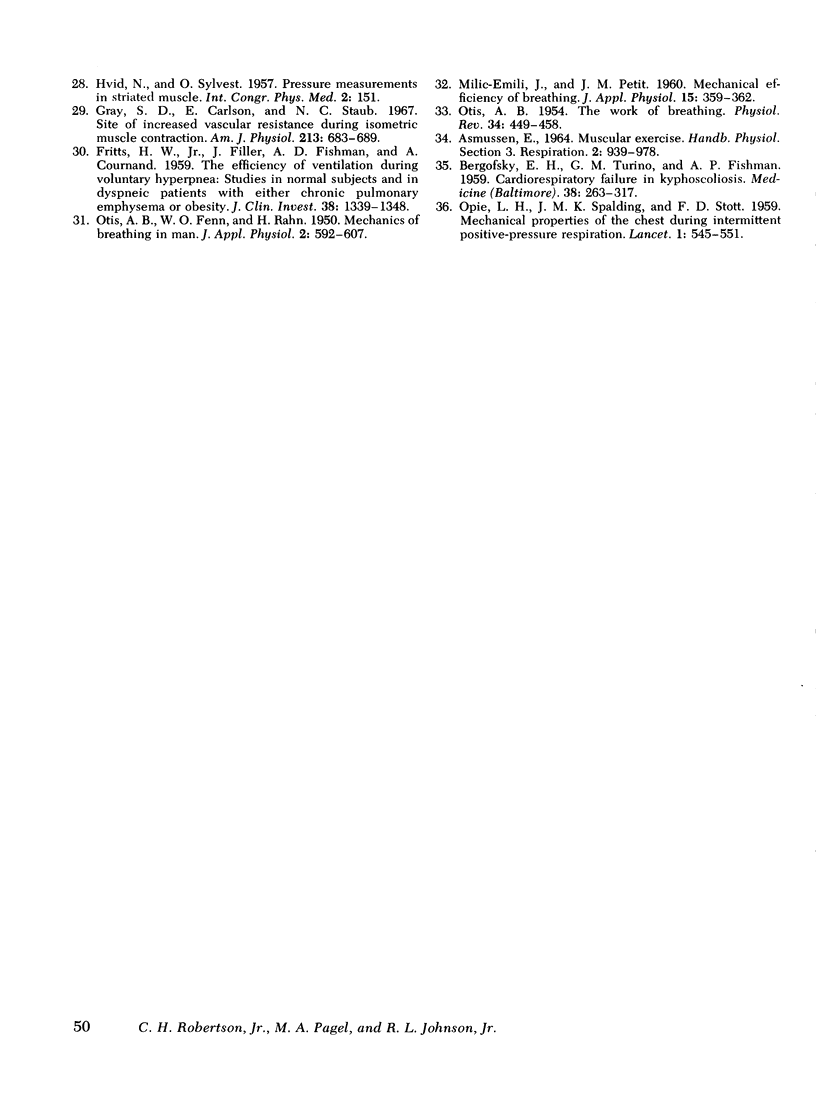Abstract
An animal model was developed to describe respiratory muscle work output, blood flow, and oxygen consumption during mechanical ventilation, resting spontaneous ventilation, and the increased unobstructed ventilatory efforts induced by CO2 rebreathing. Almost all of the work of breathing was inspiratory work at all ventilatory levels; thus, only blood flows to the diaphragm and external intercostals increased in the transition from mechanical to spontaneous ventilation, and they further increased linearly as ventilatory work was incrementally augmented ninefold by CO2 rebreathing. No other muscles of inspiration manifest increased blood flows. A small amount of expiratory work was measured at high ventilatory volumes during which two expiratory muscles (transverse abdominal and intercostals) had moderate increases in blood flow. Blood pressure did not change, but cardiac output doubled. Arterial-venous oxygen content difference across the diaphragm increased progressively, so oxygen delivery was augmented by both increased blood flow and increased oxygen extraction at all work loads. Oxygen consumption increased linearly as work of breathing increased, so efficiency did not change significantly. The mean efficiency of the respiratory muscles was 15.5%. These results differ significantly from the patterns previously observed by us during increased work of breathing induced by inspiratory resistance, suggesting a different distribution of work load among the various muscles of respiration, a different fractionation of oxygen delivery between blood flow and oxygen extraction, and a higher efficiency when shortening, not tension development, of the muscle is increased.
Full text
PDF







Selected References
These references are in PubMed. This may not be the complete list of references from this article.
- Archie J. P., Jr, Fixler D. E., Ullyot D. J., Hoffman J. I., Utley J. R., Carlson E. L. Measurement of cardiac output with and organ trapping of radioactive microspheres. J Appl Physiol. 1973 Jul;35(1):148–154. doi: 10.1152/jappl.1973.35.1.148. [DOI] [PubMed] [Google Scholar]
- BERGOFSKY E. H., TURINO G. M., FISHMAN A. P. Cardiorespiratory failure in kyphoscoliosis. Medicine (Baltimore) 1959 Sep;38:263–317. doi: 10.1097/00005792-195909000-00004. [DOI] [PubMed] [Google Scholar]
- Buckberg G. D., Luck J. C., Payne D. B., Hoffman J. I., Archie J. P., Fixler D. E. Some sources of error in measuring regional blood flow with radioactive microspheres. J Appl Physiol. 1971 Oct;31(4):598–604. doi: 10.1152/jappl.1971.31.4.598. [DOI] [PubMed] [Google Scholar]
- Daugherty R. M., Jr, Scott J. B., Dabney J. M., Haddy F. J. Local effects of O2 and CO2 on limb, renal, and coronary vascular resistances. Am J Physiol. 1967 Nov;213(5):1102–1110. doi: 10.1152/ajplegacy.1967.213.5.1102. [DOI] [PubMed] [Google Scholar]
- Domenech R. J., Hoffman J. I., Noble M. I., Saunders K. B., Henson J. R., Subijanto S. Total and regional coronary blood flow measured by radioactive microspheres in conscious and anesthetized dogs. Circ Res. 1969 Nov;25(5):581–596. doi: 10.1161/01.res.25.5.581. [DOI] [PubMed] [Google Scholar]
- FEINBERG H., GEROLA A., KATZ L. N. Effect of changes in blood CO2 level on coronary flow and myocardial O2 consumption. Am J Physiol. 1960 Aug;199:349–354. doi: 10.1152/ajplegacy.1960.199.2.349. [DOI] [PubMed] [Google Scholar]
- FRITTS H. W., Jr, FILLER J., FISHMAN A. P., COURNAND A. The efficiency of ventilation during voluntary hyperpnea: studies in normal subjects and in dyspneic patients with either chronic pulmonary emphysema or obesity. J Clin Invest. 1959 Aug;38(8):1339–1348. doi: 10.1172/JCI103909. [DOI] [PMC free article] [PubMed] [Google Scholar]
- Goldman M. D., Mead J. Mechanical interaction between the diaphragm and rib cage. J Appl Physiol. 1973 Aug;35(2):197–204. doi: 10.1152/jappl.1973.35.2.197. [DOI] [PubMed] [Google Scholar]
- Gray S. D., Carlsson E., Staub N. C. Site of increased vascular resistance during isometric muscle contraction. Am J Physiol. 1967 Sep;213(3):683–689. doi: 10.1152/ajplegacy.1967.213.3.683. [DOI] [PubMed] [Google Scholar]
- HIRVONEN L., SONNENSCHEIN R. R. Relation between blood flow and contraction force in active skeletal muscle. Circ Res. 1962 Jan;10:94–104. doi: 10.1161/01.res.10.1.94. [DOI] [PubMed] [Google Scholar]
- Hales J. R. Effects of heat stress on blood flow in respiratory and non-respiratory muscles in the sheep. Pflugers Arch. 1973 Dec 12;345(2):123–130. doi: 10.1007/BF00585835. [DOI] [PubMed] [Google Scholar]
- Kety S. S., Schmidt C. F. THE EFFECTS OF ALTERED ARTERIAL TENSIONS OF CARBON DIOXIDE AND OXYGEN ON CEREBRAL BLOOD FLOW AND CEREBRAL OXYGEN CONSUMPTION OF NORMAL YOUNG MEN. J Clin Invest. 1948 Jul;27(4):484–492. doi: 10.1172/JCI101995. [DOI] [PMC free article] [PubMed] [Google Scholar]
- Konno K., Mead J. Measurement of the separate volume changes of rib cage and abdomen during breathing. J Appl Physiol. 1967 Mar;22(3):407–422. doi: 10.1152/jappl.1967.22.3.407. [DOI] [PubMed] [Google Scholar]
- Kontos H. A., Thames M. D., Lombana A., Watlington C. O., Jessee F., Jr Vasodilator effects of local hypercapnic acidosis in dog skeletal muscle. Am J Physiol. 1971 Jun;220(6):1569–1572. doi: 10.1152/ajplegacy.1971.220.6.1569. [DOI] [PubMed] [Google Scholar]
- MCGREGOR M., BECKLAKE M. R. The relationship of oxygen cost of breathing to respiratory mechanical work and respiratory force. J Clin Invest. 1961 Jun;40:971–980. doi: 10.1172/JCI104336. [DOI] [PMC free article] [PubMed] [Google Scholar]
- MILICI-EMILI G., PETIT J. M. Mechanical efficiency of breathing. J Appl Physiol. 1960 May;15:359–362. doi: 10.1152/jappl.1960.15.3.359. [DOI] [PubMed] [Google Scholar]
- Mognoni P., Saibene F., Sant'ambrogio G., Camporesi E. Perfusion of inspiratory muscles at different levels of ventilation in rabbits. Respir Physiol. 1974 Mar;20(2):171–179. doi: 10.1016/0034-5687(74)90105-4. [DOI] [PubMed] [Google Scholar]
- Mognoni P., Saibene F., Sant'ambrogio G. Contribution of the diaphragm and the other inspiratory muscles to different levels of tidal volume and static inspiratory effort in the rabbit. J Physiol. 1969 Jun;202(3):517–534. doi: 10.1113/jphysiol.1969.sp008825. [DOI] [PMC free article] [PubMed] [Google Scholar]
- OPIE L. H., SPALDING J. M., STOTT F. D. [Mechanical properties of the chest during intermittent positive-pressure respiration]. Lancet. 1959 Mar 14;1(7072):545–551. doi: 10.1016/s0140-6736(59)92310-4. [DOI] [PubMed] [Google Scholar]
- OTIS A. B., FENN W. O., RAHN H. Mechanics of breathing in man. J Appl Physiol. 1950 May;2(11):592–607. doi: 10.1152/jappl.1950.2.11.592. [DOI] [PubMed] [Google Scholar]
- OTIS A. B. The work of breathing. Physiol Rev. 1954 Jul;34(3):449–458. doi: 10.1152/physrev.1954.34.3.449. [DOI] [PubMed] [Google Scholar]
- RAMSAY A. G. Effects of metabolism and anesthesia on pulmonary ventilation. J Appl Physiol. 1959 Jan;14(1):102–104. doi: 10.1152/jappl.1959.14.1.102. [DOI] [PubMed] [Google Scholar]
- Robertson C. H., Jr, Foster G. H., Johnson R. L., Jr The relationship of respiratory failure to the oxygen consumption of, lactate production by, and distribution of blood flow among respiratory muscles during increasing inspiratory resistance. J Clin Invest. 1977 Jan;59(1):31–42. doi: 10.1172/JCI108619. [DOI] [PMC free article] [PubMed] [Google Scholar]
- Rochester D. F. Measurement of diaphragmatic blood flow and oxygen consumption in the dog by the Kety-Schmidt technique. J Clin Invest. 1974 May;53(5):1216–1225. doi: 10.1172/JCI107668. [DOI] [PMC free article] [PubMed] [Google Scholar]
- Rochester D. F., Pradel-Guena M. Measurement of diaphragmatic blood flow in dogs from xenon 133 clearance. J Appl Physiol. 1973 Jan;34(1):68–74. doi: 10.1152/jappl.1973.34.1.68. [DOI] [PubMed] [Google Scholar]
- Rudolph A. M., Heymann M. A. The circulation of the fetus in utero. Methods for studying distribution of blood flow, cardiac output and organ blood flow. Circ Res. 1967 Aug;21(2):163–184. doi: 10.1161/01.res.21.2.163. [DOI] [PubMed] [Google Scholar]
- Sant'Ambrogio G., Decandia M., Provini L. Diaphragmatic contribution to respiration in the rabbit. J Appl Physiol. 1966 May;21(3):843–847. doi: 10.1152/jappl.1966.21.3.843. [DOI] [PubMed] [Google Scholar]


